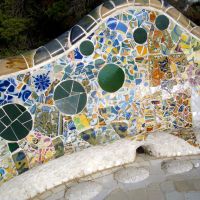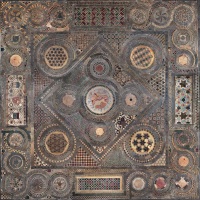Are Mosaics UNDERVALUED?
Posted by sfmosaic on February 6, 2015 · 10 Comments
How does one put a value on works made by hand? The SLOW ART of mosaic is a complex process – designing the pattern, choosing material, cutting units of tesserae that are congruent in size to the geometry and scale of the pattern, placing and setting each individual piece just so, finishing, buffing, sealing, mounting, shipping…many, many steps go into creating a mosaic work – these few words barely cover it.
My mosaic-making friend Brian Worley emailed me this photo, simply saying:
“At Abell Auction this week. Estimated value $2-3,000. Seems so undervalued…..”
OK, i got so CURIOUS: This ROMAN TABLE just came on the market at an AUCTION in Los Angeles area.

Roman Style TABLE On the Block. Will the cereal taste different today? Photo courtesy Abell Auctions
The STARTING BID is $1000. It’s estimated value is $2000 – $3000 USD.
It costs a little more than an IKEA table, but not much. Of course, you might need Hercules to move the thing, but it’s infinitely more attractive than particle board hung together with those awful faux screws. The cut stone material alone could cost more than the full asking price.
The description reads: The top having a Greek wave motif on two Corinthian style scrolling supports 123 1/4 inches wide; 49 1/4 inches deep; 30 inches high.
Its big. The wave pattern roundel is lovely, the quincunx gullioche pattern winding its way around the rectangle is very well done, and the choice of polychrome material and pattern are reminiscent the Roman Empire at its height.
Its definitely not an original Roman work, and it appears most of the tesserae pieces are cut with a saw, not by hand. Nonetheless, this pattern is obviously
hand set and very labour intensive. It nicely executed in the “face mount”, reverse or
indirect technique, using appropriate colour stone to create the fades and shades. Most likely this work was made in the Middle East, perhaps from the large commercial stone and tile mosaic workshops in Lebanon, Jordan, Tunisia, or in Turkey, or perhaps in China? We don’t know. There are many workshops that turn out reproductions and linear feet of patterned stone borders, and mosaic floor insets for Home Depot, and even for the more upscale Ann Sacks Tile.
THIS TABLE got me thinking…

Detail of the SAW CUT tesserae, so It’s not a real ROMAN piece. Who made this? photo courtesy Abell Auctions.
Often
“Real Roman mosaic” IS available at auction. Of course, it is priced upwards of 5 figures, and that is with “good and legal provenance” papers. (Yes, you’d want that.)
But what is interesting to me is that the actual MAKING has not, in essence, changed in 2500 years.
MAKERS: Hypothetically, How much would you charge if you were commissioned to make this table? Just wondering? What do you think would be appropriate price? $5000? $10,000, is $2000- 3000 about right?
Curious…
How do we price our works and
educate the public and potential clients to appreciate the thought and care that goes into a piece of work? In a commercial architectural environment in particular,
artists now compete with “robots named Arty”.
We know that hand set mosaic is priced on the following baseline:
1. size of tesserae (pieces)
2. complexity of pattern
3. time needed to complete
4. type and cost of base materials (stone, glass, and other materials)
5. studio overhead, installation, and assistants needed
What are the “hourly rates” for mosaic? What are the guidelines? Is it only dependant on what the market will bear?
Who is setting the standard, the client or the maker?
Have mosaicists received a pay raise in 3000 years? (Ok, ok…we are no longer indentured slaves, that’s a good start.)
I have heard the phrase “Things are only worth what someone will pay for it”
So what is perceived value? Why can an IKEA table out pace a stone Roman patterned table?
Is price about taste and what is ‘in fashion’?
Mosaics are adorning
haute couture fashion on the run way…even appropriated designs, printed on fabric,
a little dress costing several times more than THIS TABLE.This is a hot topic for many people who are trying to earn a living making mosaics. I’d love to hear from INTERIOR DESIGNERS, ARCHITECTS AND ART CONSULTANTS, how do you make decisions to SPECIFY MOSAIC objects, garden design work, or interior or exterior mural work?
Well, maybe go buy yourself a mosaic table this week…It’s a BARGIN!
Filed under Antiquities, Architecture, Geometry, Interiors, Mosaics, News & Culture · Tagged with ancient mosaics, antiques, antiquities, architecture, art, artisan, assemblage, auction, contemporary mosaics, craft, craftsmanship, design, hand-made, interiors, making, mosaic, Mosaics, Old Stuff, roman mosaics

















Hi Lillian,
How did you get so smart and pretty? Chiming in here: I sell “TILE” by the square foot as a wholesaler, and the showrooms that order my work for their clients add their percentage and out the door it goes! When clients order a large mural that is a custom design, the pricing is quite different and of course much
higher. What is it worth? There is no real answer of course, but it’s fun to play with the zeros. xxx
Lillian, Great post! You bring up a lot of questions about pricing and value of mosaics. I find that almost everyone requires an education in this area. Even the discerning and appreciative designers and architects that specify mosaics in their projects need to be reminded of all of the labor and skills involved in custom work. The table covers around 43 square feet and at only $50/sq ft that is over $2100. I would not consider a similar commission for this amount of money. I believe that a project of this size and complexity is more aptly priced in the $15,000+. All of us working in custom collaborative mosaic need to be clear and informative about the kind of time and energy involved in our creations or we will still be undervalued, as is this table.
Well, there you have it Karen. THANK YOU. to the point exactly. Skill, Time and Energy = VALUE. WORTH. Artists working in the field of mosaic must set themselves apart through education, skill delivery of quality items, especially because of the competition from labour workshops in china, mexico and middle east. The story behind this table remains unknown, it could be a”fire sale” item, but the auction house appears to not know what it had. I wonder if it sold this weekend?
As far as material costs are concerned I doubt it is as much as people think. If the marble is 10mm (3/8″) thick then it will be 24 kgs (48lbs) per square metre (3′ x 3′). If you look at the price of marble tiles it’s not too bad, you just need to get them cut. If we estimate that piece to be 3m x 1.2m then it would only need 87kgs. So, in GBP it would be about £200 ($305) for the marble. Not a lot, even cutting is a labourers job.
thanks Lawrence, that’s interesting. then there is the sourcing time, the knowledge of where to find the proper stone colors, and of course the cutting time (even at laborer wages) and thenat least a 20% markpup on materials that are used, otherwise you are eating it, at cost. it still may not add up to a large percentage of the cost, but in the light of education, it must to be said that there is a lot of skill in sourcing appropriate materials for a job rather than just looking at their raw cost.
WOW!!! Thank you for sharing this! Truly, unbelievable. I’m not making a living making mosaics but I’m certain the materials, alone, would cost $1000.00…not to mention the hours of setting time–even if cut with a saw! I live in LA…perhaps I’ll go check it out?! Geez, maybe it was stolen?! Do you mind if I share this article? I’ve charged half that for a single square foot mosaic… I would love to know more about it! Thanks so much for sharing.
hi fragmeo, thanks for commenting! – yes share away! I agree there is a lot of work and material here! Its prob. not stolen, is a reproduction. Roman mosaic is not the height of fashion, and it takes a particular customer to come around. Of course, at an auction, they hope for at least two people with competing interest to bid the price UP…but if they start too high, no one bids.
Great piece Lillian, this article brings up so many issues. Corners!
thanks for reading Lawrence, enjoying the conversation as it continues on my facebook page!